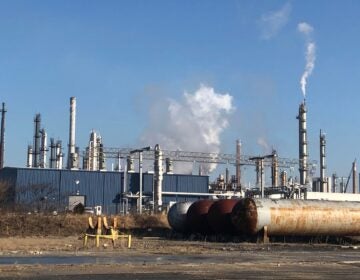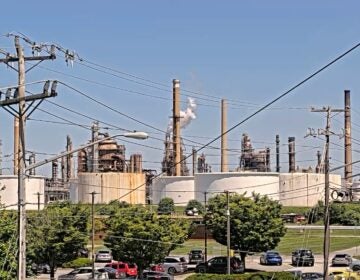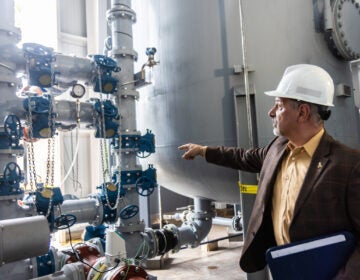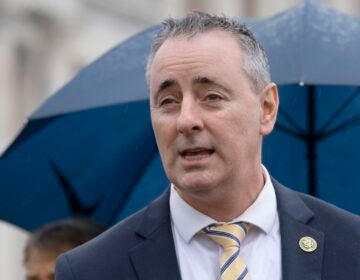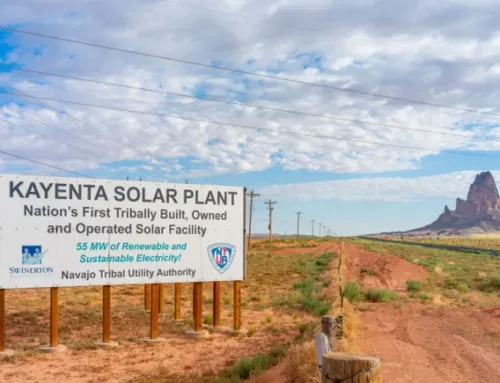Delaware City residents angry over repeated emissions from refinery
June 6, 2025
From Philly and the Pa. suburbs to South Jersey and Delaware, what would you like WHYY News to cover? Let us know!
State environmental regulators continue to assure residents who live near the Delaware City Refinery in New Castle County they’re safe, despite ongoing releases of sulfur dioxide.
The refinery, owned by PBF Energy, began emitting the toxic gas above permitted levels after its pollution control equipment failed at the end of May.
At high levels, the chemical can cause breathing difficulties, particularly for people with respiratory problems. At extremely high levels, it can be life-threatening.
During a town hall meeting Thursday evening, Department of Natural Resources and Environmental Control officials said air quality monitoring tools indicate there’s no public health threat.
Inside a cramped and humid room in a sports complex in New Castle, DNREC Secretary Greg Patterson said monitoring tools are stationed downwind of the facility — in between the refinery and residences — to accurately measure air quality.
He apologized for poor public messaging, which he said led to unnecessary panic.
“I’m taking responsibility for not communicating that more clearly,” Patterson said. “There’s not been an impact to human health from this release, which is why it hasn’t been treated that way.”
Patterson said the agency is investigating the incident, which could potentially lead to a violation.
The meeting, hosted by Democratic lawmakers state Sen. Nicole Poore and state Rep. Melissa Minor-Brown, was meant to restore trust in the community.
However, residents said they continue to be concerned about the cumulative effects of sulfur dioxide exposure.
As of 9 p.m. Thursday, the refinery continued to emit 1,450 pounds of the pollutant, and the facility’s manager said the mechanical failure won’t be fixed until late next week.
Residents say they’re also frustrated with DNREC’s response, and some have called for shutting down the refinery.
Residents want harsher penalties for the Delaware City Refinery
More than 86,000 people live within a 5-mile radius of the refinery, more than half of whom are people of color, and 20% live in low-income households, according to U.S. Environmental Protection Agency data.
George X has lived 2 miles from the refinery for decades, and is worried about health concerns reported by his neighbors over the years.
“We talked about a lot of things this evening, but they didn’t talk about when they’re going to stop the pollution,” he said. “We already know we’re being poisoned. We just want to know when you’re gonna stop.”
Residents and environmentalists for years have urged DNREC to direct harsher penalties on the refinery.
The refinery has historically been one of the region’s top polluters — releasing more than 4.6 million pounds of pollutants in 2023, according to EPA data.
The facility also has a history of violations, including three in just the past year.
In 2019, the refinery paid DNREC $950,000 to resolve a backlog of air quality violations. That same year, a fire that led to mechanical failures caused the emission of more than 842 pounds of hydrocarbons, 592 pounds of sulfur dioxide, 438 pounds of carbon monoxide, 80 pounds of nitrogen oxides and 4,300 pounds of sulfur dioxide, as well as an additional 4,300 pounds of sulfur dioxide from flaring.
According to the National Emissions Inventory, the refinery released more than 430,000 pounds of sulfur dioxide in 2020.
However, a spokesperson for the refinery said that since PBF acquired the facility from Valero Energy in 2010, there has been about an 83% reduction in sulfur dioxide emissions since 2022 compared to the last three years that Valero owned and operated it.
On Thursday, General Manager Michael Capone said he was regretful about the mechanical failure and aftermath, and promised to better communicate with the public in the future.
“We are working this thing around the clock to make sure that we get the unit complete, the work complete and the unit back online as quickly as possible,” he said.
“I want to assure all of the residents that we take each and every incident seriously. We do a detailed root cause … analysis to understand what that issue was and then we work to understand how to apply those learnings.”
Air quality experts say more air monitors needed at Delaware City
Environmental experts interviewed by WHYY News said the air quality monitoring tools utilized by DNREC are trustworthy, but multiple factors must be considered to determine whether the surrounding community is safe.
Elevation levels, wind levels and weather can all play a factor. Sulfur dioxide plumes are also typically worse at night, because air movement is more stagnant.
On-site and fence line monitoring data would paint a broader picture, said Jane Clougherty, a professor of environmental and occupational health at Drexel University’s Dornsife School of Public Health.
Refinery officials said they are required to monitor for certain chemical emissions at the facility, but it is unclear what is being detected on-site or whether the refinery is using dispersion models to determine how the sulfur dioxide is traveling.
Clougherty said though air quality monitoring is not detecting sulfur dioxide downwind of the facility, residents are not entirely out of the woods. She advises residents to keep their doors and windows closed and avoid rigorous outdoor activities.
“There is indeed still a health concern, even if the levels are near allowable limits, because there is so much variability and susceptibility across the population and some individuals will indeed still be susceptible,” Clougherty said.

Get daily updates from WHYY News!
WHYY is your source for fact-based, in-depth journalism and information. As a nonprofit organization, we rely on financial support from readers like you. Please give today.
Search
RECENT PRESS RELEASES
Related Post
